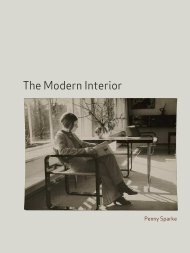Landscape Architecture: Landscape Architecture: - School of ...
Landscape Architecture: Landscape Architecture: - School of ...
Landscape Architecture: Landscape Architecture: - School of ...
- No tags were found...
Create successful ePaper yourself
Turn your PDF publications into a flip-book with our unique Google optimized e-Paper software.
landscape architects, not only one’s contemporaries and the<br />
living, but perhaps more importantly with predecessors who<br />
have been dead for decades or centuries. Any authentic work<br />
is set into the timeless tradition <strong>of</strong> artistic works and the<br />
work is meaningful only if it presents itself humbly to this<br />
tradition and becomes part <strong>of</strong> that continuum. Countless<br />
works made at all times, but particularly today, are too<br />
ignorant, disrespectful and arrogant to be accepted as<br />
constituents <strong>of</strong> the esteemed institution <strong>of</strong> tradition.<br />
Aestheticisation<br />
The Modern Movement arrived occasionally at architecture’s<br />
boundary as the consequence <strong>of</strong> aestheticisation, seeing<br />
architecture as a pure art. Particularly in our time, however,<br />
the process <strong>of</strong> aestheticisation has produced projects and<br />
buildings that have moved outside the territory <strong>of</strong><br />
architecture entirely and turned into objects <strong>of</strong> art –<br />
frequently poor art, at that.<br />
Current philosophical discourse has reintroduced the issue<br />
<strong>of</strong> beauty and ethics. The writings <strong>of</strong> Elaine Scarry, such as her<br />
small, elegant book On Beauty and Being Just, exemplify this<br />
new orientation <strong>of</strong> ethics. 17 I fully agree with Scarry’s<br />
argument for the primacy <strong>of</strong> aesthetic judgement – an idea<br />
that has been also condensed into powerful formulations by<br />
Joseph Brodsky: ‘Man is an aesthetic being before becoming<br />
an ethical being,’ 18 and: ‘Aesthetics is the mother <strong>of</strong> ethics.’ 19<br />
The poet even makes a thought-provoking statement <strong>of</strong> the<br />
evolutionary role <strong>of</strong> beauty: ‘The purpose <strong>of</strong> evolution, believe<br />
it or not, is beauty, which survives it all and generates truth<br />
simply by being a fusion <strong>of</strong> the mental and the sensual.’ 20<br />
At the same time that we see the constitutive value <strong>of</strong><br />
aesthetic aspiration and judgement, we should be critical <strong>of</strong><br />
the dubious practice <strong>of</strong> aestheticisation. In our consumer<br />
culture, aestheticisation has turned into the canniest strategy<br />
Michelangelo Antonioni, Autostrada <strong>Landscape</strong>, from ‘Cronaca di un amore’, 1961<br />
Here the director sought to convey the alienation <strong>of</strong> the road, reinforced by the<br />
two massive beverage mock-ups for advertising that create a bleak and<br />
contrasting scene for the love-torn participants.<br />
<strong>of</strong> manipulation: violence, human suffering and inequality are<br />
aestheticised today as well as politics and war. Indeed, our very<br />
lives are turning into aestheticised products that we consume<br />
as nonchalantly as the newest material products <strong>of</strong> fashion.<br />
Beauty is absolutely an inseparable part <strong>of</strong> the notion <strong>of</strong><br />
art, but it has a complex nature. Joseph Brodsky even dares to<br />
criticise Ezra Pound for his tendency to aim directly and solely<br />
at beauty: ‘The Cantos, too, left me cold, the main error was the<br />
old one: questing after beauty. For someone with such a long<br />
record <strong>of</strong> residence in Italy, it was odd that he hadn’t realized<br />
that beauty can’t be targeted, that it is always a by-product <strong>of</strong><br />
other, <strong>of</strong>ten very ordinary pursuits.’ 21<br />
In our craft <strong>of</strong> architecture, also, seductive beauty and<br />
aesthetic appeal have regrettably turned into a conscious and<br />
explicit aim. In the very same manner as in poetry,<br />
enchanting and touching beauty in architecture is a result <strong>of</strong><br />
other concerns: a desire for simplicity, precision or<br />
truthfulness, and especially for the experience <strong>of</strong> life and <strong>of</strong><br />
being human in the middle <strong>of</strong> other human beings. Every<br />
great building opens a view into the essence <strong>of</strong> the human<br />
condition and, most importantly, to an idealised and better<br />
world. This was the message <strong>of</strong> Alvar Aalto in his address to<br />
Swedish architects in 1957: ‘<strong>Architecture</strong> has a second<br />
thought … the idea <strong>of</strong> creating a Paradise. That is the only<br />
purpose <strong>of</strong> our buildings … we wish to build a Paradise on<br />
earth for people.’ 22<br />
Synthetic <strong>Landscape</strong><br />
In one <strong>of</strong> his earliest essays, Alvar Aalto praises the image <strong>of</strong><br />
an Italian town at the back <strong>of</strong> Andrea Mantegna’s painting<br />
Christ in the Garden (1460), and describes it as a ‘synthetic<br />
landscape’ or ‘an architect´s vision <strong>of</strong> the landscape’. 23 The<br />
idea <strong>of</strong> a man-made synthetic landscape, an architectural<br />
microcosm, was, in fact, the guiding idea throughout Aalto’s<br />
life, and all his buildings can be viewed as man-made<br />
microcosms steeped in their landscape settings.<br />
The architectural pr<strong>of</strong>ession at large might do better if we<br />
began to think <strong>of</strong> our buildings as microcosms and synthetic<br />
landscapes instead <strong>of</strong> seeing them as aestheticised objects.<br />
<strong>Architecture</strong> in our time has been concerned with landscape<br />
merely as a formal and visual counterpoint, or a sounding<br />
board for architectural forms. Today, however, buildings are<br />
increasingly beginning to be understood as processes that<br />
unavoidably go through phases <strong>of</strong> functional, technical and<br />
cultural change as well as processes <strong>of</strong> wear and deterioration.<br />
The fundamentally time-bound dynamic and open-ended<br />
nature <strong>of</strong> landscape architecture can provide meaningful<br />
lessons for a ‘weak’ or ‘fragile’ architecture that acknowledges<br />
vulnerability instead <strong>of</strong> obsessively fighting against time and<br />
change as architecture traditionally has done. 24<br />
The inevitable and overdue ecological perspective, a<br />
conscious and controlled interaction <strong>of</strong> nature’s systems and<br />
human lifestyles and constructions also calls for strategies that<br />
have been essential ingredients <strong>of</strong> landscape architecture. The<br />
nature–architecture relationship must by necessity be expanded<br />
22



